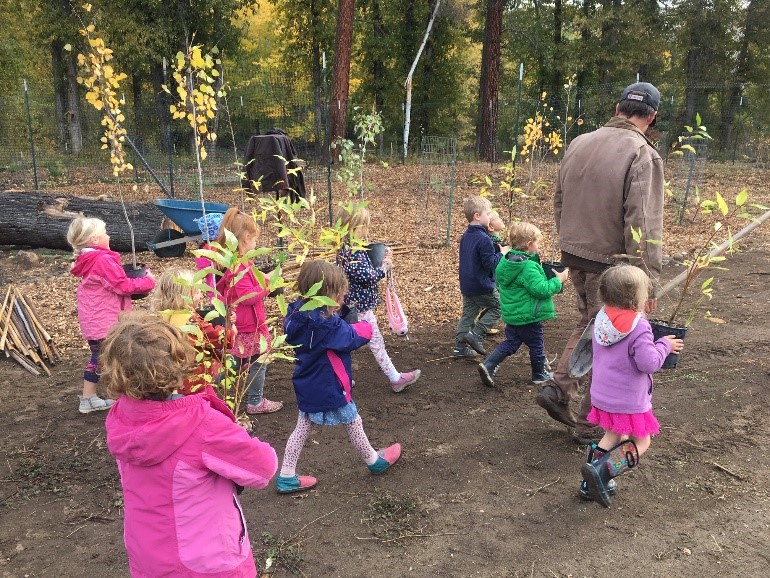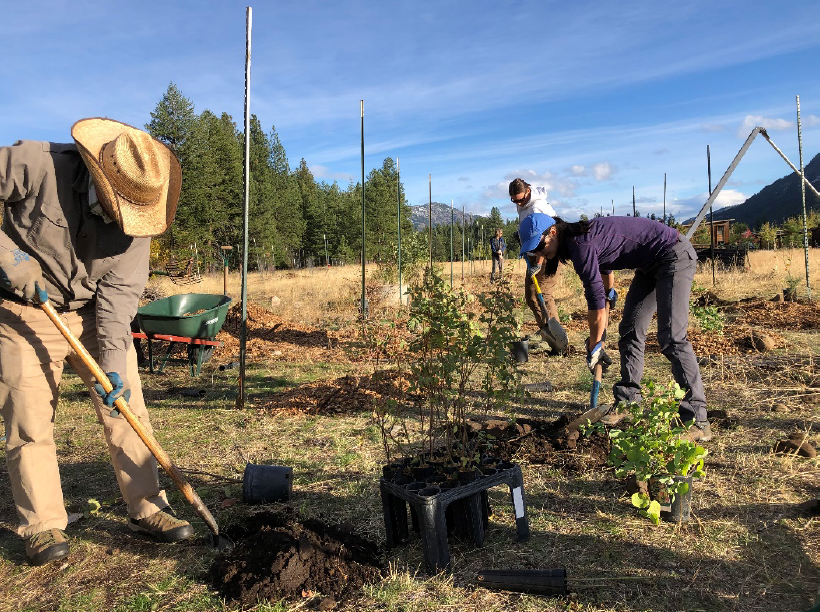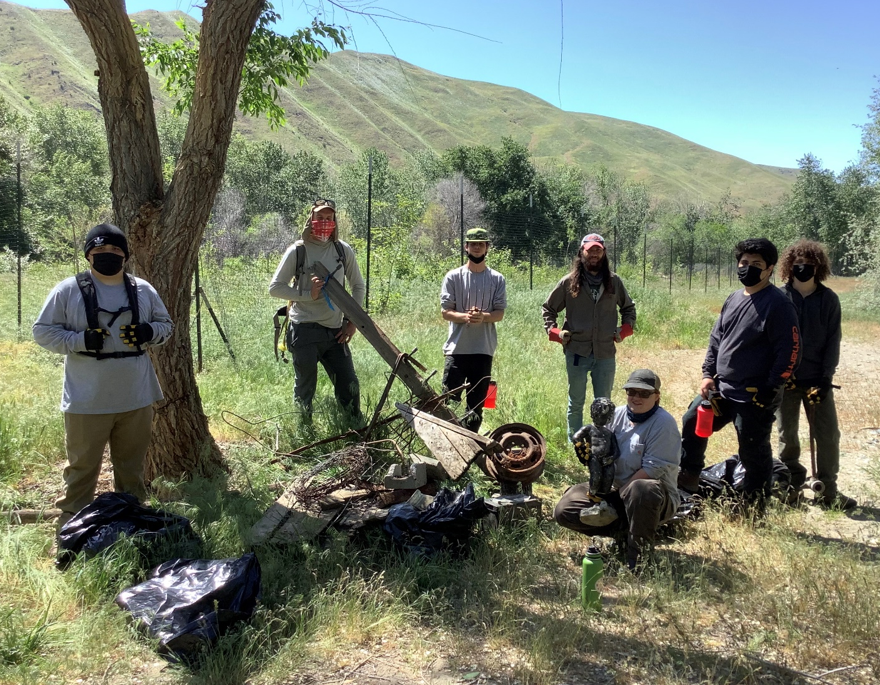
Children from Little Star Montessori helping carry trees to where they will be planted at Homestream Park. Photo by Phil Davis.
Working with partners is a large part of Ecology’s success when it comes to restoring habitat and creating natural spaces for people across Washington. Today, April 13, Washington celebrates Arbor Day. And, this year marks 150 years for the National Arbor Day Foundation, celebrated on April 29.
We thought we’d share some projects that demonstrate the spirit of the “tree planter’s holiday,” through our Terry Husseman Grant Program, in North Central Washington. With the help of partners, volunteers, and natural resource entities, we’re proud to support these projects that benefit fish and communities, now and for years to come.
Homestream Park
What started as an ambitious idea by a local landowner is now a reality with the help of a Husseman Grant to the Cascade Columbia Fisheries Enhancement Group.
Homestream Park in Winthrop was once an abandoned riverside horse paddock covered in layers of manure and weeds adjacent to the Methow River. Purchased by Phil and Cathy Davis in 2019, the property is now a welcoming space, complete with native trees and shrubs, local artwork, walking paths, and educational signs.
“Homestream Park has fast become a favorite destination for tourists and residents alike,” shared Phil Davis, landowner. “It was a haven during the stressful days of COVID, and most encouraging has been the tremendous use of the park by school-age kids both from the Methow Valley and beyond. It has been the destination for elementary school field trips from Pateros, Brewster, Oroville, and Pascal Sherman.”
Davis said the project has been a big success, helping restore the floodplain to a more natural condition.
Volunteers planted trees native to the Methow watershed, including black cottonwood, river birch, aspen, and many native shrub species. Having a healthy riparian corridor is important to all streams. They provide cooler water for fish, capture pollutants, and create wildlife and fish habitat. And these projects go further by encouraging community members as well as tourists to come and enjoy and learn more about these natural areas.
Nature & art join to tell a story
Virgil Smoker Marchand provided many poignant art pieces that demonstrate the importance of the area to native peoples. Photo by Heather Simmons
Art installations are an important feature of the park, helping to demonstrate the natural and cultural significance of the area. Virgil Smoker Marchand, a member of the Arrow Lakes Band of the Colville Confederated Tribes, provided several sculpture pieces that complement the site and remind visitors of the importance of the land to local tribes.
“This park represents salmon, water, also the dirt, soil — the environmental wholesomeness that people come to the Methow for,” shared Mr. Marchand in an interview with radio station KTRT.
Mazama Park
Mazama Park volunteer planting event drew volunteers. Photo by Kristen Kirkby
About 15 miles north of Winthrop, Cascade Fisheries is taking advantage of another Husseman Grant to reestablish healthy riparian habitat and reconnect people to nature along the Methow River in Mazama. The land trust Methow Conservancy purchased the site in the fall of 2020. Their mission is to inspire people to care for and conserve the land of the Methow Valley.
With the help of many volunteers, Cascade Fisheries installed 600 native, riparian trees and shrubs and added fencing to protect the young plants from deer. They also installed logs and other wood features to increase the habitat value and enhance the natural features of the site. Weed management and irrigation will need to occur for several years to ensure the plants survive on this dry site.
“The future Mazama Park is on its way to providing improved habitat for threatened and endangered fish and other native species,” noted Kristen Kirkby, fisheries biologist and project manager with Cascade Fisheries. “While some features of the park, including trails, gathering areas, play structure, and walk-in boater access are still in the planning stages, native plants are already putting down roots.”
Kirkby said Methow Conservancy volunteers enthusiastically got their hands dirty helping crews to replant this future public park.
“We’re grateful for the opportunity to partner with the Methow Conservancy and Ecology to improve streamside habitat for the benefit of all the members, human and otherwise, of our Methow watershed community,” Kirkby said.
The Methow Conservancy’s vision for Mazama Park is to later add walking paths, art, and educational signs, much like Homestream Park.
Lower Sleepy Hollow Preserve
On the Wenatchee River, Cascade Fisheries received a Husseman Grant to remove garbage and metal debris and to plant native trees and shrubs on the Lower Sleepy Hollow Preserve.
In 2016, this 40-acre preserve was purchased by the Chelan Douglas Land Trust to be protected in perpetuity. Located at River Mile 3, the preserve will provide the first-ever public access to intact floodplain habitat in the lower Wenatchee watershed.
Youth volunteers picked up trash before planting native trees in Lower Sleepy Hollow Preserve. Photo by Aaron Rosenblum.
“Our shared vision for this property” the project’s manager Aaron Rosenblum explained, “is to restore the floodplain and riparian habitat throughout and create a setting where Wenatchee’s urban residents, school children, tribal people, and regional conservation education non-profits can experience the Lower Wenatchee’s floodplain habitat while learning about its important ecological and cultural role in the landscape.”
In 2021, a volunteer youth party helped remove 360 pounds of garbage. Additionally, a local contractor with a walking excavator removed large pieces of metal and other miscellaneous debris from the floodplain and from a high flow side channel. All told, over 2,560 pounds of debris and garbage is no longer littering the floodplain.
Following the cleanup of debris, Cascade Fisheries installed 390 native trees and shrubs.
In addition, they worked with Chelan Douglas Land Trust and Team Naturaleza to create bilingual signs that help to create an inclusive space for the community. This park is also popular with bird watchers and school trips.
Bilingual sign created with artwork by Seiler Design LLC.
The future
The goal of Cascade Fisheries, with the assistance of the Terry Husseman Account Grant Program and other partners, is to improve water quality and instream habitat for native species, as well as to promote diverse community use, awareness, and stewardship of our local rivers.
Their work focuses on rivers providing critical habitat for three Endangered Species-listed native fish: spring Chinook, steelhead, and bull trout. Riparian plantings increase shade, nutrient input to feed river food webs, reduce erosion, and eventually increase instream habitat complexity and cover.
Their aim is to facilitate thoughtful use of river access sites for individuals, community groups, and school groups by offering volunteer stewardship events, classroom field days, and long-term student and adult stewardship opportunities. Through education and outreach, they hope to inspire a landowning public to ensure our watersheds are resilient as climate conditions continue to change.
Cascade Fisheries and Ecology hope these projects will instill a sense of stewardship, and empower communities to take action to learn about and improve watershed health wherever they may be.
For more information
The Terry Husseman Grant Program supports many projects like these all over Washington. For more information on the Husseman program, go to: Washington Department of Ecology – Terry Husseman Grant Program.
For more information on installing native trees on your property, or if you are interested in volunteering, you can contact your local fisheries enhancement group or conservation district.
For more information on Homestream Park, go to: Homestream Park
Methow Valley News Article on Homestream Park, October 2019
Across the state, see tree-planting events in Lynnwood, East Wenatchee, Duvall, Pullman, Tumwater, Oak Harbor, and Spokane Valley, some in conjunction with Earth Day events.





